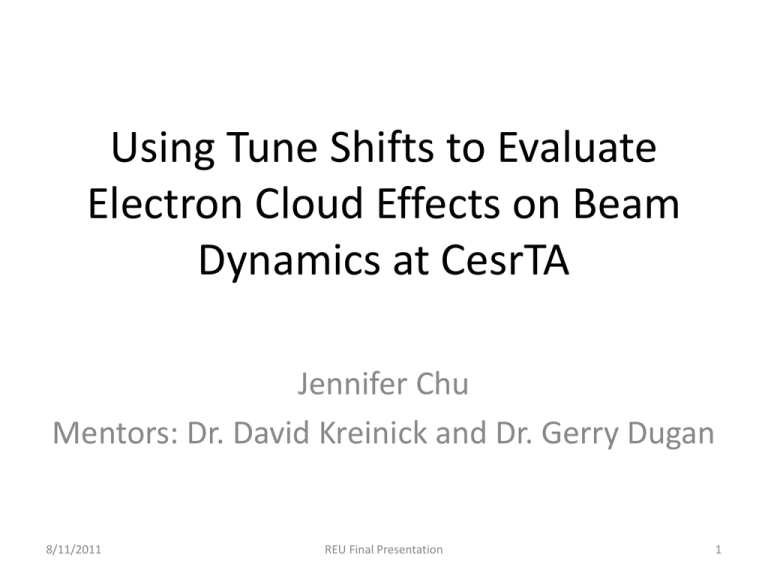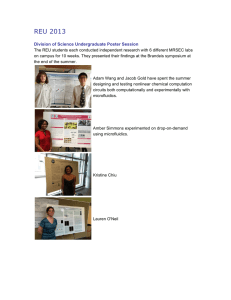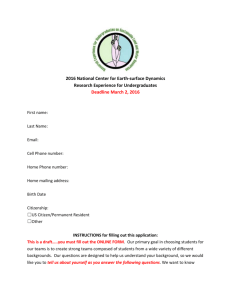Using Tune Shifts to Evaluate Electron Cloud Effects on Beam Jennifer Chu
advertisement

Using Tune Shifts to Evaluate Electron Cloud Effects on Beam Dynamics at CesrTA Jennifer Chu Mentors: Dr. David Kreinick and Dr. Gerry Dugan 8/11/2011 REU Final Presentation 1 Outline • Review of Electron Clouds and Tune Shifts • Simulations of New Data • Varying the Simulation Parameters 8/11/2011 REU Final Presentation 2 Electron Clouds • • • • ILC will collide electrons and positrons Accelerating charges radiate Photons knock electrons off walls of beampipe Photoelectrons are accelerated by beam and knock off more electrons, forming a cloud • Electrons in the cloud are attracted to positive beams 8/11/2011 REU Final Presentation 3 Tune Shifts • Beams are displaced from nominal path • Tune (Q): number of oscillations of a particle about nominal path, per turn around the ring • Tune shift (ΔQ): difference in tune caused by electric field of electron cloud 8/11/2011 REU Final Presentation Qy = 9.52 4 Taking Data • CesrTA is used to measure tune shifts • Beams are set into oscillation • BPMs measure the position for 2048 turns • Fourier transform is used to calculate tune shifts 8/11/2011 REU Final Presentation 5 POSINST • POSINST is a simulation code used to model the electron cloud effects • Simulations are run for different values for each of five parameters which describe the physics of electron cloud generation • Simulations are compared to data to test accuracy of the model 8/11/2011 REU Final Presentation 6 Comparing Data to Simulations 8/11/2011 REU Final Presentation 7 Goals • We want to find the optimal set of parameters that most accurately models electron clouds • The simulation can then be used to predict the behavior of electron clouds in damping rings of future linear colliders 8/11/2011 REU Final Presentation 8 Submitting Jobs to the Queue • Simulations were run on Cornell’s batch nodes • Each job is only allowed 48 hours I monopolized the queues for the summer: of CPU time 87 data sets • I wrote code to x 5 simulation parameters parallel process the x 2 for x, y tune shifts simulations to get x 6 jobs per submission ----------------------------------more statistics > 5000 total jobs 8/11/2011 REU Final Presentation 9 Calculating Tune Shifts • I used Mathematica to post-process the results of POSINST to calculate the tune shifts • I superimposed the tune shifts from multiple simulations onto plots of the data for comparison 8/11/2011 REU Final Presentation 10 June 2011 Coherent Tune Shift Data • • • • • • • • 2.085 GeV e+: 20 x 0.5 mA 2.085 GeV e+: 45 x 0.5, 1.0, 1.5, 2.0 mA 4.00 GeV e+: 20 x 0.2, 0.4, 0.6, 0.8, 1.0, 1.2, 1.4, 1.6, 1.8, 2.0 mA 4.00 GeV e+: 45 x 0.2, 0.4, 0.6, 0.8, 1.0, 1.2 mA 5.3 GeV e+: 20 x 0.5, 1.0, 2.0 mA 5.3 GeV e-: 20 x 1.0, 2.0, 3.0, 4.0, 5.0, 6.0, 7.0, 8.0, 9.0 mA 5.3 GeV e+: 45 x 0.2, 0.4, 0.6, 0.8, 1.0, 1.2 mA 5.3 GeV e-: 45 x 0.2, 0.4, 0.6, 0.8, 1.0, 1.2, 1.4, 1.6, 1.8, 2.0, 2.2, 2.4, 2.6 mA Bunch spacing studies: • 2.085 GeV e-: 30 x 0.2, 0.4, 0.6, 0.8, 1.0, 1.2 mA for 12, 16, 20 ns spacing • 2.085 GeV e-: 45 x 0.2, 0.4, 0.6, 0.8, 1.0, 1.2 mA for 4, 8, 12 ns spacing 8/11/2011 REU Final Presentation 11 2.1 GeV 4.0 GeV 5.3 GeV 0.50 mA/bunch 0.40 mA/bunch 0.50 mA/bunch 1.00 mA/bunch 1.00 mA/bunch 1.00 mA/bunch 8/11/2011 REU Final Presentation 12 Simulation Parameters • Parameters describe the physics of electron cloud generation • When a radiated photon from the beam knocks into the wall of the beampipe, photoelectrons are generated • (1) Quantum Efficiency: number of electrons generated for every photon 8/11/2011 REU Final Presentation 13 Secondary Emission • Photoelectrons are accelerated by the electric field of the beam and continue to produce more electrons • (2) Secondary Emission Yield (SEY): number of secondary electrons generated for every primary electron • (3) Energy at the SEY Peak 8/11/2011 REU Final Presentation 14 Types of Secondary Electrons • When a photoelectron hits a wall of the vacuum chamber, it can: 1. Bounce off (elastic) 2. Interact with material (rediffused) 3. Knock off electrons in material (true) • (4) Fraction of Secondaries that are Rediffused • (5) Fraction of Secondaries that are Elastic 8/11/2011 Sketch of the currents that are used to define the different components of secondary emission. Figure taken from M. Furman and G. Lambertson, “The electron-cloud instability in the arcs of the PEP-II positron ring” REU Final Presentation 15 Varying the Simulation Parameters 8/11/2011 REU Final Presentation 16 Summary • Tune shifts are used to study electron clouds • Simulations were run and compared to data for all five parameters and all 77 new data sets • Model seems to work reasonably well for a variety of beam energies and bunch currents • Finding the optimal parameters will allow the model to be used for future linear colliders 8/11/2011 REU Final Presentation 17



